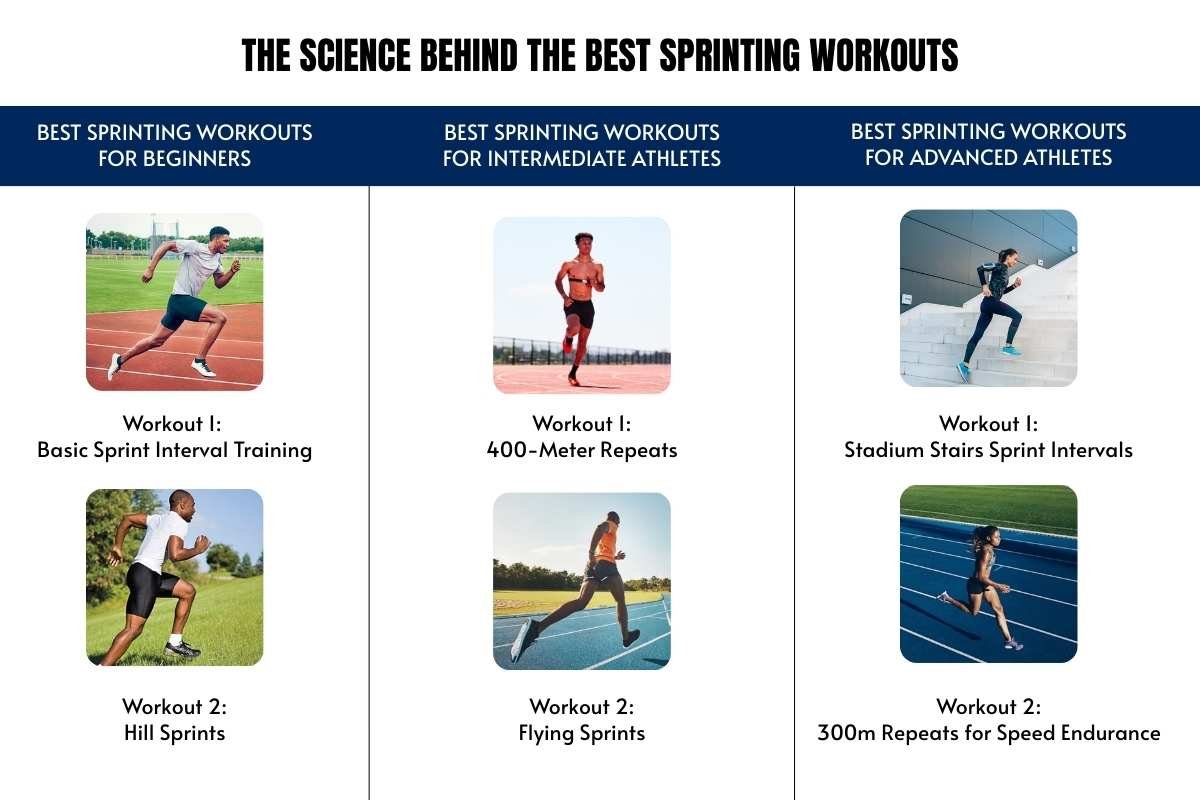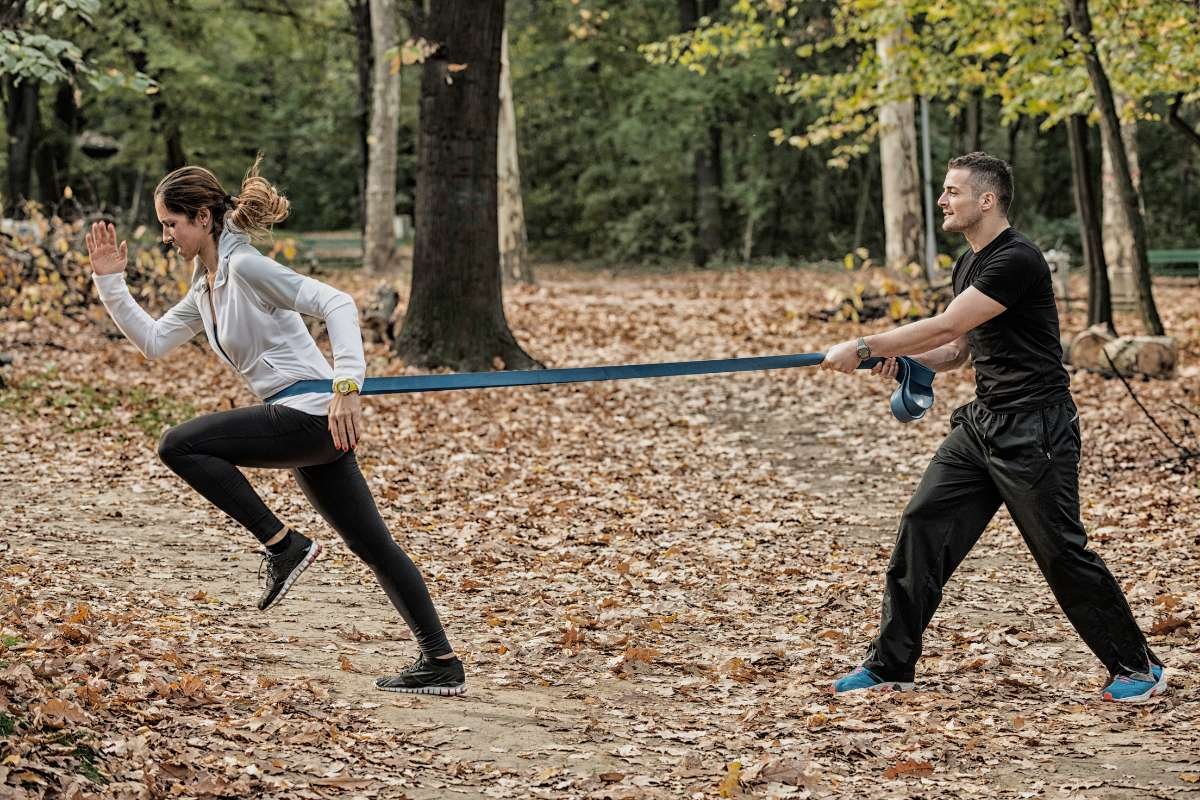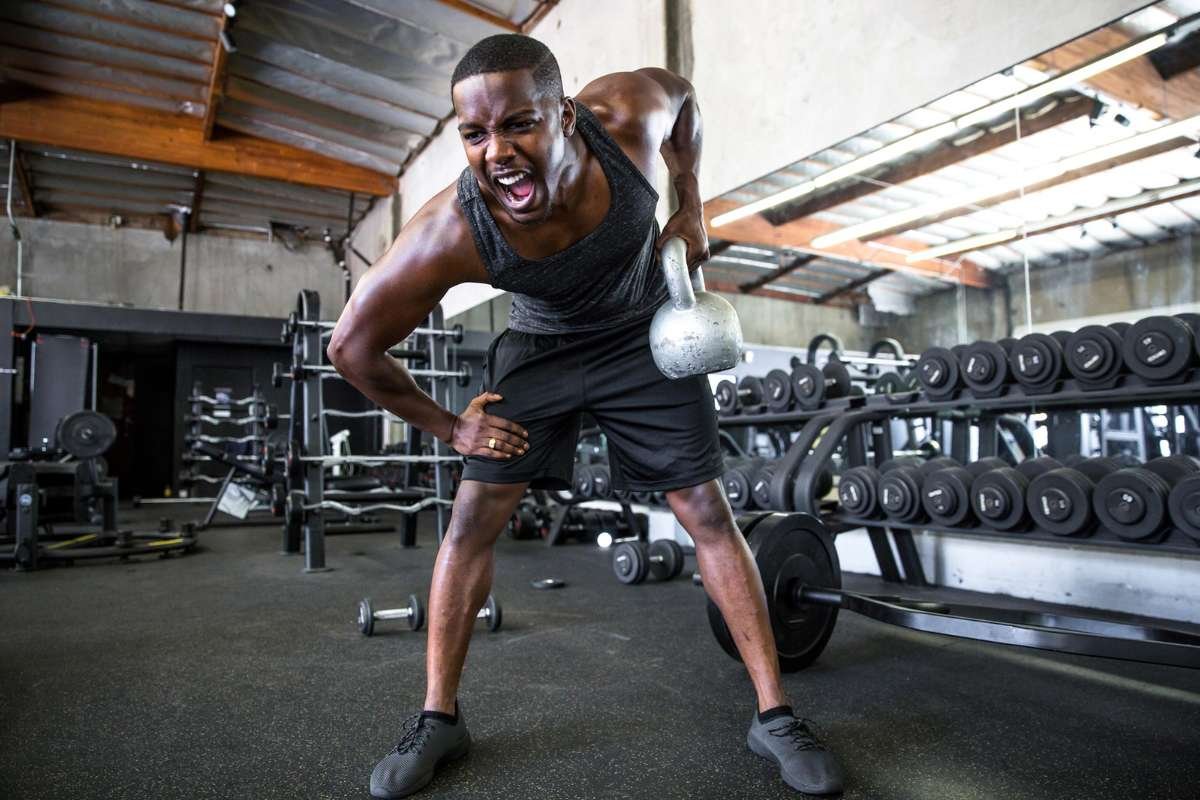Think about reaching your fitness goals. Also, losing unwanted fat, increasing speed, or gaining amazing endurance, in a rapid time. While there is a place for long, slow cardio, scientific research is revealing a much more powerful and effective way of achieving your fitness goals. That is called sprinting. The short duration of intense effort requires a higher demand on your body. The studies have shown that it has other benefits over a traditional jog.
What if I told you that you could completely change your body? And also improve your metabolism and develop permanent strength. All without spending countless hours on a treadmill?
If you are ready to find the most impactful and time-efficient way to unlock your complete athletic potential and finally meet some fitness goals. Then keep reading to find out the best sprinting workouts to change your training!
The Science behind the Best Sprinting Workouts:
To put it simply, sprinting is running at your top speed or a percentage of your top speed over a short distance or short period of time. Sprints are both a cardiovascular and anaerobic exercise.
The key scientific aspect behind the best sprinting workouts is simple. Sprinting activates the body’s quickest energy systems, including the ATP-PC and anaerobic glycolysis. These workouts rapidly supply power for explosive efforts without relying on oxygen. This high-intensity training stimulates essential hormonal responses like increased growth hormone and testosterone. It also boosts fat oxidation, supporting muscle growth and effective recovery.
Sports scientists and strength coaches agree that sprinting itself is the most potent training stimulus for speed improvement. They recommend mixed methods with sprinting, plyometrics, and strength training to develop horizontal power effectively.
Let’s go through some of the workouts for different levels of athletes, from beginner to advance.
Source: https://pmc.ncbi.nlm.nih.gov/articles/PMC6872694/

Best Sprinting Workouts for Beginners:
Get ready to redefine your fitness. These two beginner-friendly sprinting workouts are designed to help you build speed, torch fat, and boost your endurance, no matter where you are in your fitness journey:
Workout 1: Basic Sprint Interval Training
This workout is perfect for beginners and can be done on a track, a field, or a treadmill. The key is to alternate between short bursts of high-intensity effort and longer periods of active recovery.
Steps:
- Warm-up: Start with a 5-minute brisk walk or light jog to get your muscles warm and your heart rate up.
- Sprint: Sprint at about 80% of your maximum effort for 30 seconds.
- Recovery: Walk slowly for 90 seconds. This is your recovery period, allowing you to catch your breath.
- Repeat: Repeat this 30-second sprint and 90-second recovery cycle 5-8 times.
- Cool-down: Finish with a 5-minute walk and some light stretching.
YouTube Tutorial:
- “SPRINT TRAINING 101 WITH FULL WORKOUT” by Strong With Kelly:
Workout 2: Hill Sprints
Hill sprints are an excellent way to build strength and power without putting as much stress on your joints as flat-ground sprinting. The incline naturally forces you to use proper form.
Steps:
- Find a hill: Look for a hill with a moderate incline that is safe to run on. It doesn’t need to be long; 20-30 meters is a great start.
- Warm-up: Start with a 5-minute walk, followed by some dynamic stretches like leg swings and high knees.
- Sprint: Sprint up the hill for 10-15 seconds at a challenging but controlled pace. Focus on driving your knees up and pumping your arms.
- Recovery: Walk slowly back down the hill to your starting point. This serves as your recovery period.
- Repeat: Repeat this sprint and recovery cycle 4-6 times.
- Cool-down: Walk around on a flat surface for 5 minutes to cool down, then stretch.
Also Read:
- Your No-Nonsense Guide to HIIT Workout for Female Beginners
- The 5 Best Quad Stretches for Runners and Cyclists
- Best Sports for Losing Weight: A Fun and Effective Way to Shed Pounds
YouTube Tutorial:
- “HILL REPEATS RUNNING made EASY – a SIMPLE guide!” by Ben Parkes:
Best Sprinting Workouts for Intermediate Athletes:
If you’ve mastered the basics and are ready to take your speed and endurance to the next level. These intermediate-level best sprinting workouts will challenge you to push past your current limits. They focus on improving your speed endurance and top-end sprinting ability.
Workout 1: 400-Meter Repeats
This classic track workout is designed to build speed endurance, which is the ability to maintain a high speed for a longer duration. It teaches your body to handle the buildup of lactic acid, making you faster for longer.
Steps:
- Warm-up: Jog lightly for 10 minutes, followed by dynamic stretching like high knees, butt kicks, and leg swings.
- Sprint: Sprint a full 400 meters (one lap on a standard track) at a fast, but controlled pace. This should be around 85-90% of your max effort.
- Recovery: Take a 2-4 minute rest period. You can walk or stand, but focus on lowering your heart rate before the next sprint.
- Repeat: Complete 4-6 repetitions of the 400-meter sprint and recovery cycle. The goal is to keep your sprint times consistent.
- Cool-down: Finish with a 10-minute jog or walk and thorough static stretching.
YouTube Tutorial:
- “Example Workout 8 x 400m: SPEED? AEROBIC Intervals? Running Tips Basics” by Coach Sage Canaday:
Workout 2: Flying Sprints
Flying sprints are designed to improve your top-end speed by eliminating the acceleration phase. You reach your maximum velocity before the timed segment, allowing you to focus purely on maintaining your fastest possible speed.
Steps:
- Warm-up: Perform a 10-15 minute warm-up with dynamic movements and a few short, easy striders to get your muscles firing.
- Build-up: Start 20-30 meters before your designated sprint zone. Slowly accelerate to a near-top speed.
- Sprint: Begin your all-out sprint for a timed 30-40 meter zone. Focus on maintaining a fast, powerful stride with good arm drive. This should be a 95-100% effort.
- Deceleration & Recovery: Slowly decelerate after the sprint zone and walk back to your starting point for a full recovery (at least 3-4 minutes).
- Repeat: Complete 5-8 repetitions of the entire sequence.
- Cool-down: Walk for 5-10 minutes and perform static stretches for your quads, hamstrings, and glutes.
Also Read:
YouTube Tutorial:
- “Flying Sprints (Flying Start) – Sprint Float | Speed Training” by Simple Speed Coach:
Best Sprinting Workouts for Advanced Athletes:
Sprinting at a top level requires a strategic approach that goes beyond basic intervals. These advanced workouts are designed to challenge your anaerobic capacity. They will also improve your top-end speed and sharpen your running mechanics.
Workout 1: Stadium Stairs Sprint Intervals
This workout is a powerful alternative to traditional track work, as it builds explosive power, speed endurance, and muscular strength in the glutes, hamstrings, and quads. It’s a great way to challenge your body in a new environment.
Steps:
- Warm-up: Start with a 10-15 minute warm-up that includes jogging, dynamic stretches, and leg swings to prepare your muscles for the high-intensity work ahead.
- The Ascent: Sprint up the stairs two steps at a time for maximum power and explosiveness. Drive your knees high and use your arms to propel you forward. The goal is a fast, powerful climb, not a leisurely jog.
- The Descent: Walk back down the stairs one step at a time. This serves as your active recovery and allows you to catch your breath before the next repetition.
- The Drill: Start with a challenging number of repetitions. Sprint up the stairs and walk down, repeating the cycle 6-10 times. For an added challenge, perform a “full flight” sprint, running all the way to the top of the stadium section before walking back down.
- Cool-down: After completing your reps, perform a 5-10 minute cool-down with a light jog and thorough stretching, focusing on your legs and core.
YouTube Tutorial:
- “STAIRS WORKOUT FOR SPEED & AGILITY” by Swezen Kizito:
Workout 2: 300m Repeats for Speed Endurance
This workout challenges the athlete’s ability to maintain a fast pace for a longer duration, which is crucial for sports that require repeated high-speed bursts. It builds anaerobic capacity and mental toughness.
Steps:
- Warm-up: Begin with a comprehensive warm-up, including jogging, dynamic movements, and a few short strides to prime your body for the workout.
- The Repetition: Run 300 meters at a fast, but controlled pace (e.g., aiming for your 400-meter race pace, if you have one). The effort should be high, but sustainable, allowing you to complete multiple repetitions without a complete breakdown in form.
- Recovery: Take a long, active recovery period. Jog or walk for 5-8 minutes between each repetition. The goal is to feel mostly recovered for the next sprint, as this workout focuses on quality over quantity.
- Reps: Start with 3-4 repetitions and gradually increase the number as your fitness improves. This is a very demanding workout, so be prepared for a challenge.
- Cool-down: Finish with a light jog and extensive stretching, particularly for your hamstrings, glutes, and quadriceps.
Also Read:
- Recovery Exercises for Athletes: Boosting Performance and Preventing Injuries
- Keto Diet for Professional and Amateur Athletes
- Nutrition Tips and Recovery Foods for Athletes
- Best Ways To Prevent And Treat Athlete’s Foot
YouTube Tutorial:
- “Final Altitude Workout: 300m & 400m Repeats in Sedona” by Benjamin Preisner:
Benefits of Best Sprinting Workouts (Backed by Science & Experts):
1. Burns Fat Efficiently

Sprinting elevates metabolism and triggers excess post-exercise oxygen consumption (EPOC), meaning you burn calories even after the workout. A study in the Journal of Obesity (2017) found that sprint interval training led to significant reductions in body fat compared to steady-state cardio.
2. Builds Speed & Power
Sprinting activates fast-twitch muscle fibers (Type II) that are crucial for explosiveness and athletic performance. Usain Bolt famously said, “You just have to develop strength, power, acceleration, and technique.” Sprinting is the ultimate way to train all four.
3. Improves Cardiovascular & Anaerobic Fitness
Sprinting boosts both aerobic capacity (VO₂ max) and anaerobic capacity, making your heart and lungs stronger. A 2020 study in Frontiers in Physiology showed sprint interval training increased VO₂ max as effectively as traditional endurance training in less time.
Programming Your Best Sprinting Workouts:

Planning your best sprinting workouts involves structuring warm-up, sprint intervals, recovery, and cool-down. This optimizes performance and minimizes injury risk. Key elements include setting sprint duration or distance, choosing appropriate recovery times, determining total volume based on fitness level, and progressively increasing intensity.
A typical beginner plan balances sprint effort with active recovery, lasting about 20-30 minutes.
| Phase | Activity | Duration / Distance | Intensity | Notes |
| Warm-up | Light jogging + stretches | 5-10 minutes | Easy | Prepare muscles and joints |
| Sprint 1 | Sprint | 30 seconds or 50 meters | Max effort | Focus on form and speed |
| Recovery 1 | Walking / slow jog | 2 minutes | Low | Active recovery |
| Sprint 2 | Sprint | 30 seconds or 50 meters | Max effort | Maintain good form |
| Recovery 2 | Walking / slow jog | 2 minutes | Low | Prevent fatigue |
| Repeat | Sprint + Recovery cycles | 5-6 rounds | Alternating | Adjust based on fitness |
| Cool-down | Slow jog + stretching | 5-10 minutes | Easy | Help with recovery and flexibility |
Expert Tips & Resources on Sprinting:
Quotes & Advice from Experts
1. Usain Bolt:
“There are no secrets. You just have to develop strength, power, acceleration, and technique.” — On what underpins great sprinting performance.
Bolt’s coach, Glen Mills, told him early on: “You have to learn how to lose before you can learn how to win.” Bolt reflects that: “You will fail at some point… What’s important is what you take away and learn from it.”
2. Shelly-Ann Fraser-Pryce:
On technique: when she was starting, she says she “ran with a really bad running posture… Stephen [Francis] saw all of this… took a year to actually go through my core needs.” By focusing on posture, first stride, arm placement, and phases of sprint, she improved. “You feel all of your phases, like a sixth sense. So I focus on nailing each phase properly…”
Books & Authoritative Resources:
1. What We Need is Speed
- Author: Henk Kraaijenhof
- What you’ll learn: Emphasis on speed phases, combining strength/preparation, recovery, and periodization. Recommended by Louie Simmons and other speed trainers.
2. Sprinting: Training, Techniques and Improving Performance
- Author: Chris Husbands
- What you’ll learn: Covers event distances (60-400 m), biomechanics, limiting factors, technique, and training drills. Good for athletes wanting both theory + application.
Conclusion
Realizing your athletic potential and reaching your fitness goals is a journey. You can integrate the best sprinting workouts into your routine. These workouts are not just about running. It is about changing your metabolism, establishing strength for the long haul. It also helps in showing yourself what you’re actually capable of. Now you know the material, you have a plan, so put your shoes on and run as fast as you can toward the best version of yourself!
FAQ:
1. How often should I do sprinting workouts each week?
Most athletes benefit from 2–3 sprinting sessions per week. Sprinting is high-impact and requires longer recovery, so it’s best not to sprint daily. Sports physiologist Stephen Seiler notes that elite sprinters balance sprint training. They blend it with recovery and strength work to maximize adaptation.
2. Do I need special equipment for sprinting workouts?
No, but the right gear helps. Lightweight running shoes, a stopwatch or sprint timer app, and access to a track, field, or hill are ideal. Resistance sleds or bands can be added later for advanced training.
3. Can I combine sprinting with weight training?
Yes. In fact, sprinting and strength training complement each other. Lifting improves sprint power, while sprints build explosiveness. A common approach is to separate heavy lifting and sprinting on different days. Or do sprints before weights if training on the same day.







